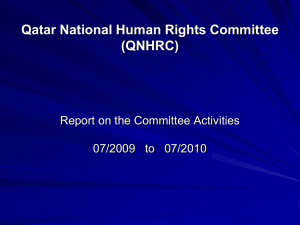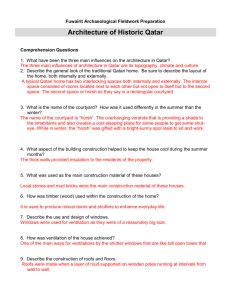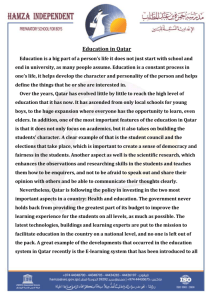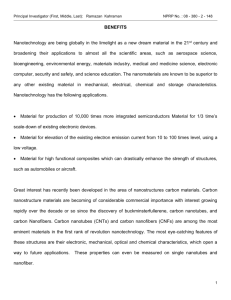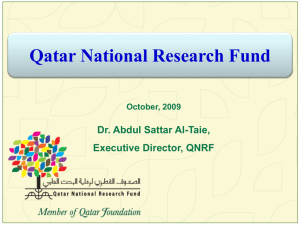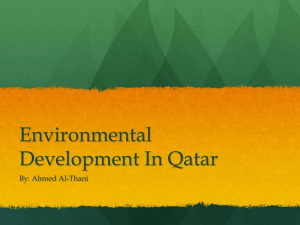The RAND Corporation is a nonprofit institution that helps improve... decisionmaking through research and analysis.
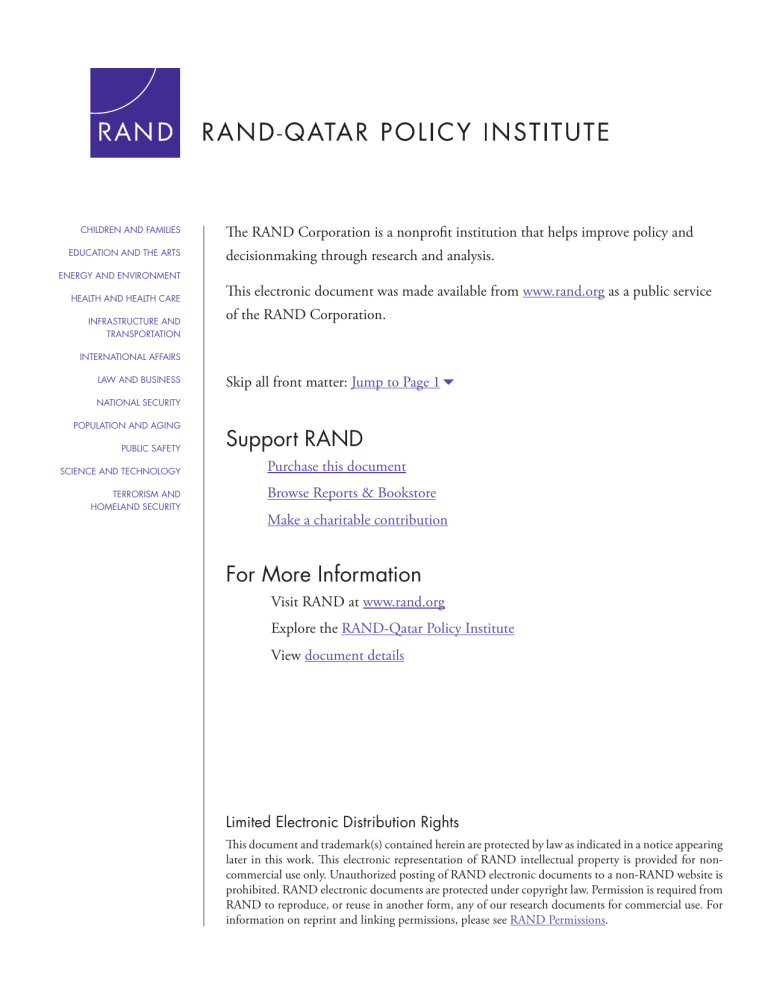
CHILDREN AND FAMILIES
EDUCATION AND THE ARTS
ENERGY AND ENVIRONMENT
HEALTH AND HEALTH CARE
INFRASTRUCTURE AND
TRANSPORTATION
INTERNATIONAL AFFAIRS
LAW AND BUSINESS
NATIONAL SECURITY
POPULATION AND AGING
PUBLIC SAFETY
SCIENCE AND TECHNOLOGY
TERRORISM AND
HOMELAND SECURITY
The RAND Corporation is a nonprofit institution that helps improve policy and decisionmaking through research and analysis.
This electronic document was made available from www.rand.org
as a public service of the RAND Corporation.
Skip all front matter: Jump to Page 1 6
Support RAND
Purchase this document
Browse Reports & Bookstore
Make a charitable contribution
For More Information
Visit RAND at www.rand.org
Explore the RAND-Qatar Policy Institute
View document details
Limited Electronic Distribution Rights
This document and trademark(s) contained herein are protected by law as indicated in a notice appearing later in this work. This electronic representation of RAND intellectual property is provided for noncommercial use only. Unauthorized posting of RAND electronic documents to a non-RAND website is prohibited. RAND electronic documents are protected under copyright law. Permission is required from
RAND to reproduce, or reuse in another form, any of our research documents for commercial use. For information on reprint and linking permissions, please see RAND Permissions .
This product is part of the RAND Corporation technical report series. Reports may include research findings on a specific topic that is limited in scope; present discussions of the methodology employed in research; provide literature reviews, survey instruments, modeling exercises, guidelines for practitioners and research professionals, and supporting documentation; or deliver preliminary findings. All RAND reports undergo rigorous peer review to ensure that they meet high standards for research quality and objectivity.
REPORT
Launching the Qatar National
Research Fund
Shelly Culbertson • Michael G. Mattock • Bruce R. Nardulli • Abdulrazaq Al-Kuwari
Gary Cecchine • Margaret C. Harrell • John A. Friel • Richard E. Darilek
Sponsored by the Qatar Foundation
RAND-QATAR POLICY INSTITUTE
This research was sponsored by the Qatar Foundation for Education, Science, and
Community Development and was conducted under the auspices of the RAND-Qatar
Policy Institute and the Transportation, Space, and Technology Program within RAND
Infrastructure, Safety, and Environment.
Library of Congress Cataloging-in-Publication Data is available for this publication.
ISBN: 978-0-8330-5341-4
The RAND Corporation is a nonprofit institution that helps improve policy and decisionmaking through research and analysis. RAND’s publications do not necessarily reflect the opinions of its research clients and sponsors.
R
®
is a registered trademark.
© Copyright 2012 RAND Corporation
Permission is given to duplicate this document for personal use only, as long as it is unaltered and complete. Copies may not be duplicated for commercial purposes.
Unauthorized posting of RAND documents to a non-RAND website is prohibited. RAND documents are protected under copyright law. For information on reprint and linking permissions, please visit the RAND permissions page (http://www.rand.org/publications/ permissions.html).
Published 2012 by the RAND Corporation
1776 Main Street, P.O. Box 2138, Santa Monica, CA 90407-2138
1200 South Hayes Street, Arlington, VA 22202-5050
4570 Fifth Avenue, Suite 600, Pittsburgh, PA 15213-2665
RAND URL: http://www.rand.org
To order RAND documents or to obtain additional information, contact
Distribution Services: Telephone: (310) 451-7002;
Fax: (310) 451-6915; Email: order@rand.org
Summary
In its first five years of operation, the Qatar National Research Fund (QNRF) grew from a small start-up to a research-funding institution that had awarded about $500 million in research grants. It was the first institution of its kind in the Middle East, starting in 2006 with a small staff and a broadly outlined vision. Within months of starting, it had launched its first program, the Undergraduate Research Experience Program (UREP). In spring 2007, it launched the National Priorities Research Program (NPRP), its primary funding vehicle.
In its first 11 funding cycles, the UREP—in which undergraduates enrolled in Qatar’s universities participate in research projects mentored by faculty—made awards totaling about
$15 million to about 1,500 students in all of Qatar’s universities. In its first five rounds of funding, the NPRP, QNRF’s grant program for professional researchers, awarded about $485 million to research teams in Qatar that partnered with researchers from institutions in more than
30 other countries. Through these programs, QNRF has also laid the foundation for a domestic research infrastructure in Qatar to support the growing research communities in Qatar
University and Doha’s Education City, home to six branch campuses of U.S. universities.
While QNRF has developed significantly since that time, this report discusses its startup from August 2006 through January 2008, including the initial analysis, decisions made, implementation, and early results. During this period, the RAND-Qatar Policy Institute
(RQPI) served as advisor and worked hand-in-hand with QNRF’s director and growing staff to provide analysis, aid in project planning, design programs, contribute to making pivotal policy decisions, draft key documents, make programs operational, and ensure quality in processes and products. Figure S.1 shows the initial time line of the start-up of QNRF.
In 2004, before the start-up, at the request of the Qatar Foundation for Education, Science, and Community Development (QF), RQPI had created an initial design for QNRF as well as business and implementation plans. The new organization was envisioned to become an internationally recognized institution that would use research as a catalyst for “expanding and diversifying the country’s economy; enhancing the education of its citizens and the training of its workforce; and fostering improvements in the health, well-being, environment and security of its own people and those of the region” (Greenfield et al., 2008).
The proposed institution had three goals:
• Building human capital
• Funding research in the interest of Qatar, the region, and the world
• Raising Qatar’s profile in the international research community.
The first goal, building human capital, was the most important in the early phases.
xiii
xiv Launching the Qatar National Research Fund
Figure S.1
Initial Start-Up Time Line of QNRF
QNRF start-up begins; staff are hired; governance and legal structure are established
UREP is designed and launched
Administrative and policy infrastructure is put in place
QNRF-RQPI team designs NPRP
NPRP is launched
January
2006
RAND TR722-S.1
December
2006
July
2007
January
2008
Laying the Foundation for Ongoing Operations: Creating an Infrastructure for Governance and Management
Before QNRF could begin operations and launch its first grant programs, several basic building blocks had to be in place. The fund’s legal standing needed to be determined, and an arrangement for governance had to be created. An organizational structure also needed to be worked out, and staff had to be hired.
Choosing QNRF’s Legal Form
The QF Board of Directors opted to make QNRF a subsidiary of its parent, QF. An alternative option had been to make it an independent legal entity with its own governing board and guidance from QF, but the QF leadership decided that the new research fund would be better served with the leadership and financial support available to it as a QF center. It was also decided that once QNRF had sufficient staffing, policies, and experience as an organization, its governance would transition to a board-led model, still under QF authority. Following this plan, an interim steering committee was appointed in lieu of a board, with members affiliated mainly with QF and institutions in Education City. The steering committee could meet more regularly than a board, could make decisions more quickly, and would allow greater flexibility during the start-up period.
Designing an Organizational Structure and Hiring Staff
A core team of QNRF staff was hired in late 2006. This team consisted of a start-up director, a special-projects officer, and two program managers. Given QNRF’s ambitions, however, a detailed organizational structure and additional staff were needed in short order. The QNRF-
RQPI team decided to use the model of a matrix organization, in which employees would
Summary xv assume different roles, depending on the organization’s needs at any given time. This allowed a small number of employees to take on an array of responsibilities as circumstances required.
Lessons Learned from QNRF’s Governance and Management Structure
The QNRF-RQPI team took away two key lessons from the experience of building QNRF’s structure: First, QNRF remained understaffed during the start-up because the organizational structure was too “lean” and because of difficulties in hiring qualified staff. Second, the flexibility of the steering committee was very important during the start-up, so QF decided to keep the steering committee, although it planned to add a higher-level governing board at some point in the future.
Guiding Principles for the Design of QNRF’s Research Programs
Having laid the foundation for operations, the QNRF-RQPI team turned to designing QNRF’s first programs. As a first step, it worked out six guiding principles to which it could refer as it developed programs and policies:
• QNRF programs should aim to create a research culture in Qatar, focusing on building human capital.
• Program designs should include attractive incentives for researchers and institutions.
• Programs need one set of policies that can accommodate research in different parts of the world.
• Programs require “buy-in” (support and feedback) from participating institutions in order to effectively meet those institutions’ needs.
• QNRF should learn from its own experiences in designing programs and should make improvements.
• QNRF policies should be clear, transparent, and consistently applied.
Planning and Launching the Undergraduate Research Experience Program
In keeping with the guiding principle that QNRF should learn from its experiences as it designs successive grant programs, the QNRF-RQPI team decided to first launch the UREP,
QNRF’s funding vehicle for faculty-mentored undergraduate research projects. The team knew that the UREP would be significantly smaller than the NPRP. Tackling it first would allow the new organization room for experimentation and trial-and-error experience with a lower-stakes program, yet the process of designing its policies and administration—creating the program with university input, writing a request for proposals (RFP), soliciting applications, setting up a peer-review process and scoring system, and finding peer reviewers—would be a smaller-scale model for the NPRP. In addition, the UREP would be manageable for QNRF’s small start-up staff.
Because there was a push to demonstrate QNRF’s viability as an organization as quickly as possible, the QNRF-RQPI team began designing the UREP in the first months of the start-up phase, while it was establishing the fund’s basic operational structure. Recognizing that students form Qatar’s future workforce, the QNRF-RQPI team wanted the UREP to
xvi Launching the Qatar National Research Fund create opportunities for Qatar’s undergraduate population. Therefore, it designed a program that would award grants to faculty at universities in Qatar to direct research projects staffed by undergraduates. The mentoring involved would supplement normal classroom instruction, and “learning by doing” would improve the quality of participating students’ education, give them practical collaborative experience, and perhaps inspire them to continue their studies at the graduate level.
The first UREP RFP was issued in October 2006, a few months after QNRF itself came into existence. Faculty at universities in Qatar submitted a total of 120 proposals—roughly four times the response rate anticipated in QNRF’s original business plan. Peer reviewers recruited from institutions around the world rated more than half of these submissions “very good” or
“excellent,” and 61 proposals received funding. In the UREP’s first round, QNRF awarded a total of $1,322,000 in grants to the universities that submitted proposals. The UREP had similar results in its second and third funding cycles. As QNRF’s first program, the UREP had demonstrated that QNRF could start and run a research-granting program.
Planning the National Research Priorities Program
With policies in place and the experience gained in running the UREP, QNRF could turn its focus to its main vehicle for supporting research in Qatar, the NPRP. The scale envisioned for the NPRP called for the QNRF-RQPI team to do considerable planning and to make a number of key decisions. The most important planning priorities were
• The nature and structure of the program
• The program’s research priorities
• The peer-review process
• The RFP
• Intellectual property (IP) policies.
The original concept for the NPRP in the 2004 business and implementation plans was a program that would fund no more than 16 large multi-investigator grants at universities in
Qatar. However, the diversity and creativity of the proposals submitted for the UREP were encouraging, and the process of making award decisions on the basis of merit in open competition had had promising results. With that in mind, the QNRF-RQPI team decided that taking the same approach with the NPRP might better support creation of a dynamic research community in Qatar and achieve more of QNRF’s objectives. The team thus decided that the
NPRP would issue a general RFP and evaluate the proposals on merit, without considering the institutions involved.
A similar rethinking took place with regard to the research topics the NPRP would fund.
It had originally been thought that QNRF would award NPRP grants to projects on specific, preselected research topics that are pivotal to Qatar’s national interests, but when the time came to choose these research priorities, it proved inappropriate for QNRF to decide what they should be. Choosing priorities meant determining what would not be funded as well as what would be funded. Deciding among these kinds of trade-offs would be politically sensitive; would take research, time, and negotiation among stakeholders to produce a definitive list; and
Summary xvii would require endorsement by higher levels of authority in Qatar. Thus, prioritizing specific and exclusive research topics could potentially delay the launch of the NPRP indefinitely.
Consequently, the team decided to view NPRP research priorities through the lens of building capabilities rather than funding specific areas. The NPRP would accept proposals of applicants’ choosing, in any research field. Award decisions would then be based on the degree to which the proposed projects would help meet QNRF’s goals of building human capital; funding research in the interest of Qatar, the region, or the world; and raising Qatar’s profile in the international research community. Building human capital through creating research capability in Qatar was the first priority. In later cycles, the program could broaden its focus to achieve progress on the other goals.
To promote building human capital in Qatar, the team integrated a carefully chosen set of incentives and requirements into the RFP:
• It encouraged intellectual freedom by allowing researchers to submit proposals for topics of their own design and determined technical merit through competition.
• It provided a non-exclusive list of suggested sample topics to motivate researchers’ thinking about research areas of importance to Qatar.
• The majority of the budget spent and at least half of the work done would be in Qatar, and certain key personnel for projects would have to reside in the country.
• It allowed about one-third of the project budgets to be administered by research institutions abroad, as research collaboration is a very effective way to build human capital.
• It encouraged collaboration among institutions in Qatar.
• It provided incentives for participating institutions to establish needed policies and infrastructure to support research in Qatar.
• Applicants had to submit a letter of intent before proposals were due (the QNRF-RQPI team envisioned this as a way to get a head start on the task of lining up peer reviewers).
To facilitate the peer-review process (which would rely on researchers in respected research organizations around the world and not in institutions in Qatar that were eligible for the grants) and to help in decisionmaking in awarding NPRP grants, the QNRF-RQPI team instituted a “bin” system for the NPRP. When an applicant submitted a proposal, he or she was asked to choose one of seven bins (based on research discipline—for example, industry and engineering or social sciences) in which the proposal would compete. The bin system offered a number of advantages: Proposals in the same very general domain would compete only with each other, enabling QNRF to ensure diversity in the topics funded, and grants would go to the best proposals in each discipline. This would make it easier for QNRF staff to select peer reviewers. It also gave QNRF a means of prioritizing different disciplines or bins for funding if at some point in the future it should choose to do so.
Developing an IP policy was essential for the NPRP. The number and variety of stakeholders that might be involved in a QNRF grant—individual researchers, branch campuses in
Education City, Qatar University, universities in the United States and Europe, private companies, and QF—made for a very complicated IP environment. Different stakeholders had varying IP policies and interests.
RQPI recommended an IP solution serving several purposes:
• To create an environment that would encourage innovation
xviii Launching the Qatar National Research Fund
• To permit compatibility between QNRF policies and the policies of QNRF grantees’ home institutions
• To incentivize institutions to establish IP infrastructure
• To support the goal of generating revenue from IP.
The solution specified that when a grantee’s home institution has an IP policy, QNRF should adopt a compatible policy. For institutions that do not have a policy in place, QNRF should utilize the prevailing international model, used throughout the United States and
Europe. In this model, the researcher’s home institution owns the rights to the IP, while the revenue is split evenly among the researcher, the researcher’s department, and the researcher’s institution (with a small portion of the last third going to QF). QNRF accepted this as a guideline, then negotiated individual agreements with grant recipients.
Launching the National Research Priorities Program
With the initial NPRP design complete, QNRF released the program’s first RFP in April 2007.
The QNRF-RQPI team conducted extensive outreach and heavily publicized the program in an effort to ensure the success of the first funding cycle. Taking a calculated risk, QNRF developed a basic online application system. More than 200 proposals were submitted by the deadline of August 2007, and after administrative review, 175 proposals moved on to peer review.
QNRF set a target of obtaining five peer reviewers per proposal, a considerable challenge, since QNRF had compressed the time line for making award decisions, wanting to make announcements by December, and the number of QNRF staff was limited. In addition,
QNRF had set the bar for peer-reviewer qualifications very high, with requirements more stringent than those at many academic journals. The QNRF-RQPI team divided the work of finding enough qualified peer reviewers and also enlisted help from research-granting organizations that already had peer-reviewer databases.
By mid-November, the QNRF-RQPI team had lined up reviewers for most of the proposals. The effort went far toward meeting QNRF’s original target: Most of the 175 proposals had four or more reviewers, while only 33 had three reviewers.
The QNRF-RQPI team recognized that it was essential in this first round of NPRP funding to set a precedent for transparency in the award process, as the impression created at the start could gain or lose the confidence of the research community. Consequently, the team decided to base funding solely on the numerical scores submitted by the peer reviewers, rather than using a panel process or having a committee make funding match certain research priorities. The team also opted to use an absolute, across-the-board standard score to make final decisions about which proposals to fund, instead of a relative standard in which proposals would be evaluated with respect to competing proposals in their bin. As it turned out, the first-round proposals had fairly even scores across all of the bins. Whether or not to determine different cut-off scores for each bin was not an issue.
The NPRP’s first grants were awarded in December 2007. Of the 175 proposals that went to peer review, 47 were funded, for a total of $25 million over three years. At least one grant was awarded in each of the seven bins, and each major institution that submitted a proposal received a share of the funding.
Summary xix
Looking Ahead for QNRF
With QNRF, QF has taken solid steps toward achieving its goal of making Qatar a center of innovative education and research. In a short period of time, QNRF has grown from a few people to a grant institution with fully operational multimillion-dollar programs and the groundwork of a domestic research infrastructure in place. Since that time, QNRF has done much to expand and deepen its policies, build relationships with research institutions, and refine its programs.
Nevertheless, much remains to be done. Over time, QNRF will need to take next steps and meet a variety of fresh challenges. To truly become an internationally respected researchgranting and managing organization, it will need to make changes in programs and policies to better meet the needs of Qatar’s research community and goals.
Future developments will also require changes in QNRF’s approach, management structure, policies, programs, and metrics. In 2007, the government of Qatar made a public commitment to significantly expand its investment in scientific research and technological development by dedicating 2.8 percent of its revenue to the effort. In 2012, QF began a stakeholder-driven process to develop a national research strategy for Qatar and focused research priorities. QNRF will be a key entity in supporting the new national research strategy. In light of that new strategy, QNRF will need to carefully examine its focus, governance and management infrastructure, policies, and programs, some already planned and some as yet unimagined. In addition, QNRF may benefit from developing further measurements of research outcomes. These are just a few of the many tasks still to be accomplished.
